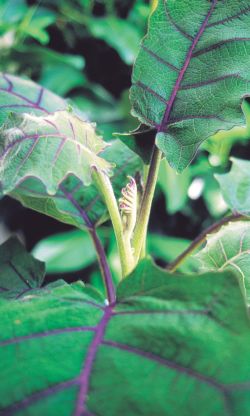Plant
Doctor Archive
 Saving
a naranjilla Saving
a naranjilla
 I
really need help to save my Naranjilla plant (Solanum quitoense).
I bought it last year and for six months it grew well, from its
original height of 35cm to a glorious 1.45m. It had beautiful giant
leaves, green on top, purple under, that measured 50-60cm long and
about the same width. The bottom leaves started to go brown and
drop off, leaving my plant looking like a long prickly stalk with
big leaves at the top. I
really need help to save my Naranjilla plant (Solanum quitoense).
I bought it last year and for six months it grew well, from its
original height of 35cm to a glorious 1.45m. It had beautiful giant
leaves, green on top, purple under, that measured 50-60cm long and
about the same width. The bottom leaves started to go brown and
drop off, leaving my plant looking like a long prickly stalk with
big leaves at the top.
One day I noticed it
had a thin cobweb all over it, with what looked like tiny spiders
all through it. I sprayed with Mavrik but now all the new leaves
are curled up and look like closed fists and the flowers that are
produced go brown and drop off as well as the leaves. Now my beautiful
plant looks sad. Please help, my plant needs you!
 FROM
your description, your plant has been attacked by mites. These tiny
creatures attack plants by sucking the sap from the leaves. They
are identifiable by the fine cobwebbing on the plant and they can
attack garden plants as well as houseplants. FROM
your description, your plant has been attacked by mites. These tiny
creatures attack plants by sucking the sap from the leaves. They
are identifiable by the fine cobwebbing on the plant and they can
attack garden plants as well as houseplants.
Mites multiply or breed
very quickly, especially indoors. Mites travel on currents of air,
and if there is insufficient air circulation indoors or around a
plant, then they will multiply much more quickly on a single plant.
Mites also love warm dry environments so being indoors during winter
is their ideal holiday retreat.
Spraying with Mavrik
is fine, but if you wish you can use Yates Mite Killer, which has
been specifically designed to control mites. Spray as per the directions
on the container, and always spray outdoors. If you can, put your
plant outside on a warm sunny day to try and disperse some of the
mites on a good breeze. On some plants, you can hose the mites off
with a jet of water, but you have to be careful on plants that don't
like water on their leaves.
Weekend
Gardener, Issue 127, 2003, Page 27
Reproduced with permission from the former Weekend Gardener magazine. The views expressed here are not necessarily those of the RNZIH.
|
 |
 |
|